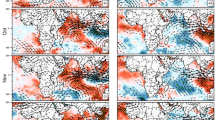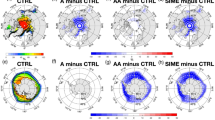Abstract
East Asian summer monsoon simulated by a coupled ocean-atmosphere general circulation model developed in the Institute of Atmospheric Physics (IAP CGCM) is analyzed. The precipitation, low-level streamline field, sea level pressure, low-level temperature and mixing ratio are compared with the observed ones respectively.
The results show that IAP CGCM can simulate most features of summer monsoon circulation, but it still has some important systematic errors. The simulated Somali jet tends to be much weak and lies too far south. The cross-equatorial flows between 120°E and dateline are also too weaker in the model than those in reality, while the South Asia monsoon low is stronger than that in the observation and reaches further east. At the same time, the subtropical high in the western Pacific extends too far west and north. Accompanied by these deviations in tropical and subtropical zones, the westerly troughs in the middle and high latitudes affect further southerly regions in China than those observed. All these deficiencies in simulating summer monsoon circulation result in the errors in modelled precipitation in East Asia, which include the underestimation of precipitation over East Asia in summer, the premature emergence of maximum precipitation and the further southerly rainfall belt in East Asia than the observed one. So the most obvious drawbeck of the model is the apparent underestimation of Meiyu frontal rainfall.
Similar content being viewed by others
References
Chen Keming, Jin Xiangze, Lin Wuyin, Yu Yongqiang, Guo Yufu and Zhang Xuehong (1996), Simulation of gradually increasing induced climate change with a coupled ocean-atmosphere general circulation model, Study on Climate Change and Numerical Simulation, Edited by Chen Longxun, China Meteorological Press, 107–122 (in Chinese).
Chen Longxun, Zhu Qiangen and Luo Huibang (1991), The East Asia monsoon, China Meteorological Press, 1–30 (in Chinese).
Chen Qiying (1996), The simulation of regional climate and climate change in East Asia with IAP CGCM, Master Thesis of IAP / CAS (in Chinese).
Dai Yongjiu (1995), The land processes model and its coupling with GCM, doctoral thesis of IAP/CAS (in Chinese).
Ding Yihui, Zhao Shenrong and Zhang Jie (1987), Global tropical and subtropical divergent circulation at 200 hPa in summer of the Northern Hemisphere, Acta Meteorologica Sinica, 45: 120–127.
Dong Ming (1990), Atmosphere circulation in the tropics, Tropical Meteorology, 6: 3.
Guo Yufu, Yu Yongqiang, Chen Keming, Zhang Xuehong and Jin Xiangze (1995), Mean climate state simulated by a coupled ocean-atmosphere model, Theoretical and Applied Climatology, 55: 99–113.
Latif, M. et al. (1994), Climate variability in a coupled GCM Part II: The Indian monsoon, J. Climate, 7: 1449–1462.
Lin Zhaohui (1995), The mechanism of feedbacks in climatic model and improvements of model, doctoral thesis of IAP / CAS (in Chinese).
Shukla, J. and Fennessy M.J. (1992), Some idealised experiments to diagnose the simulated Asian summer monsoon variability, WCRP-68, WMO/TD-No. 470, Geneva, Switzerland, 2153–2157.
Sperber, K.R. et al. (1994), Simulation of the Northern summer monsoon in the ECMWF model: sensitivity to horizontalresolution, Mon. Wea. Rev., 109: 2337–2356.
Tao Shiyan and Chen Longxue (1987), Akevrew of recent research on the East Asian summer monsoon in China, Monsoon Meteorology, 760–92.
Xue Feng (1991), The diagnoses analyses and validation of climate simulation of IAP AGCM, Doctoral Thesis of IAP/CAS (in Chinese).
Wang Huijun and Bi Xunqiang (1996), The East Asian Monsoon Simulation with IAP AGCMs-A Composite Study, Advances in Atmospheric Sciences, 13: 260–264.
Wang Shaowu (1994), Advance in climate modelling, Meteorological Monthly, 12: 9–10 (in Chinese).
Yu Yongqiang (1994), The simulation of global and regional climate with IAP CGCM, Master Thesis of IAP / CAS (in Chinese).
Yuan Chongguang (1990), Modelling the summer monsoon in China, Scientia Atmospherica Sinica (Special issue), 46–52.
Zeng Qingcun, Liang Xinzong and Zhang Minghua (1988), Simulation on the abrupt change of monsoon and the general circulation, Scientia Atmospherica Sinica (special issue), 22–24.
Zhu Qiangen, He Jinhai (1985), Circulation at high level during the set up and middle term oscillation of Asian monsoon, Tropical meteorology, 1: 9–18.
Author information
Authors and Affiliations
Rights and permissions
About this article
Cite this article
Qiying, C., Yongqiang, Y. & Yufu, G. Simulation of east Asian summer monsoon with IAP CGCM. Adv. Atmos. Sci. 14, 461–472 (1997). https://doi.org/10.1007/s00376-997-0064-3
Received:
Revised:
Issue Date:
DOI: https://doi.org/10.1007/s00376-997-0064-3




